#ryuichi kaneko
Photo

Photography historian Ryuichi Kaneko around the mid-1970s to early 1980s, photo by Shinzo Shimao.
57 notes
·
View notes
Text

Treasures of Japanese Photography, History Tanpei Photo Club Hikari
Kotaro Iizawa, Ryuichi Kaneko
Kokusho Publishing Association
290 notes
·
View notes
Text

Japanese Photobooks of the 1960’s & 1970’s by Ryuichi Kaneko & Ivan Vartanian (Eiko Hosoe)
1 note
·
View note
Text
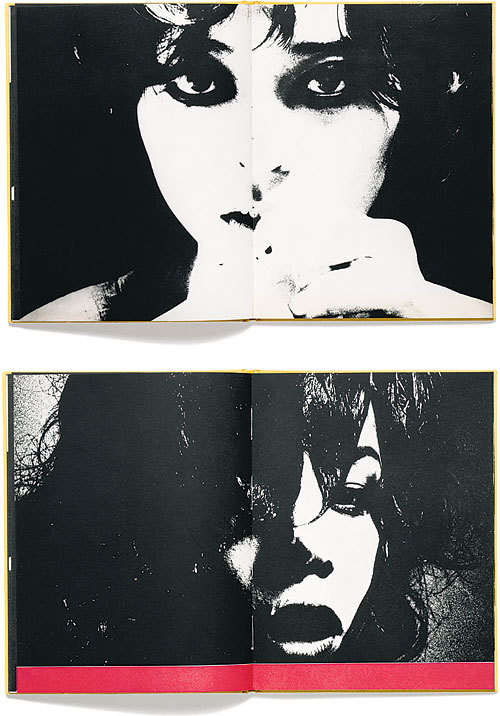
JAPANESE PHOTOBOOKS OF THE 1960s AND '70s
By Ryuichi Kaneko and Ivan Vartanian.
0 notes
Photo
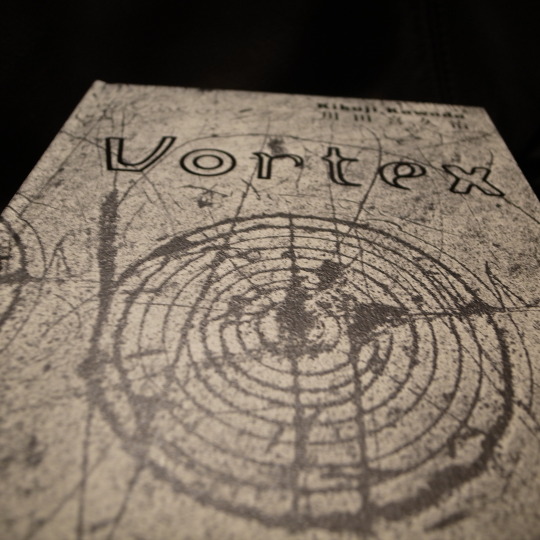
Kikuji Kawada, Vortex [signed]
Akaaka Art Publishing Inc, 2022
On September 5th, 2018, in one of his early Instagram posts, Kikuji Kawada shared a photograph of a poster that read: "Everything was beautiful and nothing hurt."1 This quote, by Kurt Vonnegut, is extracted from his masterpiece Slaughterhouse-Five, praised as "one of the most enduring antiwar novels of all time."2, 3 Vonnegut, an American novelist born of German parents, enlisted in the U.S. Army during World War II, in 1943, when he was 21 years old. Captured by the Germans during the Battle of the Bulge, he was taken as a prisoner of war in Dresden, where he survived the Allied bombing in a meat locker of the slaughterhouse where he was detained. This experience provided the traumatic substance of his novel, but also the somewhat comedic undertone of the style that he came to be known for. His work became an emblem of American post-war counterculture. It seems quite fitting that Kawada would pick Vonnegut's words and make them his own through the prism of social media. He tagged this post with "#kurtvonnegutjr," "#スローターハウス5" and "# なにもかもうつくしく" : "Everything is beautiful." A few hours later, that same day, he posted another photograph: rows of cars in flames in the aftermath of a typhoon, as seen in the news, on a TV screen. The poetic irony of this sequence echoes Vonnegut's quote, and Kawada's entire oeuvre, starting with Chizu (The Map). [...]
Like Vonnegut, Kawada uses his art to sublimate a pain that is profound, and indescribable. In his photographs, everything is beautiful because it hurt. What remains from insane, natural or manmade destruction, is only made beautiful through the eye of the artist that transcends it. Kawada's more recent work, be it "The Last Cosmology", "Los Caprichos" or his latest photographs, published in this book, seems to be a prolongation of this epiphany: as if he needed to go back to this moment, as if it had become an obsession.
In the history of Japanese photography and in the history of photography at large, Kawada stands out. An iconoclast and a self-admitted contrarian, he offers a vision of the world that is personal, spiritual, and elevated. To photo historian Ryuichi Kaneko, he once jokingly told an anecdote about Yukio Mishima's perplexed reaction to Chizu: "I overheard him asking, 'What kind of 'stains' are these? Stains left by what?' I was a bit contrary back then, you know. I said, 'That's for you to imagine, sir'."6
His work is for us all to imagine: Kawada always steered clear of the literal. This may be in part because a literal narrative form would not allow him to express the weight of his experience. Writing about Belgian photographer Anton Kusters's work on the memory of the concentration camps, photography historian Fred Ritchin explained: "The German novelist W. G. Sebald felt that 'the recent history of his country could not be written about directly, could not be approached head-on, as it were, because the enormity of its horrors paralyzed our ability to think about them morally and rationally,' as Mark O'Connell wrote in the The New Yorker on the tenth anniversary of Sebald's death. 'These horrors had to be approached obliquely.'"7
This seems to be Kawada's approach: an oblique way of telling the story, and blending the genres. A tongue-in-cheek approach to the gravity and the seriousness of our condition -the coping mechanism of the traumatized. His existential irreverence is in no small part what draws us into his universe, and what makes him stand out.
Kawada's work could be defined as layered documentary. He explains: "An image taken of the 'present,' whenever that is, is so strong--vivid in hue, aspect, substance--because it's a document. I seek even now to explore new forms for documentary to take. When you layer things in the way we've been discussing, the layers produce meaning, metaphors emerge as you go deeper into the juxtapositions that arise, and the ways of seeing the image multiply."8[...]
With Covid-19, reality started to look more and more like fiction. The masks that Kawada used in his "Los Caprichos" series, his masterful tribute to Goya's eponymous social fables, made over 40 years ago, took a deeper meaning. On October 16th, 17th, and 18th in 2021, he posted a series of photographs that hinted at his eerie prescience. In a personal essay he wrote in 2016, published in Remote Past a Memoir: 1951-1966, Kawada recalled a traumatic brain surgery: "I was desperate to recollect my memories from a mere few hours ago. Being in this dark place had brought more fear upon me than the thought of brain surgery. After a while my memories came back to me in a trembling surge. Suddenly, I saw an array of photographic negatives floating before my eyes. In pursuing these images where light and darkness were reversed, I had found myself lost and unable to distinguish between past and future..."16
This is the emotion that he masterfully channels and makes visible in his photographs: negative turned positive, positive turned negative. His disturbing and ominous images are a place of excavation, of traumas either lived or foreseen. The world they describe - his world, Tokyo - appears like Dante's Inferno, both flooded and in flames. By combining vivid colors that range from burning flames to ice blue, by playing with contrasts and textures, Kawada generates a series of fantasies, a world that is perpetually at war, but still standing. In that same essay, he writes: "It is by no means an overstatement to say that all I can remember from my memories extending across the distant horizon are places of ruin and chaos... The catastrophe of the 100 Suns and the fear of cesium remain still lurking in our future skies. The conversation between father and daughter continues to be repeated like a spell of sorts, 'You know daddy, the world is going to end tomorrow.' 'What, the world will end tomorrow?'" Looking at his photographs,we don't know if we are witnessing the end or the beginning of the world.17
Kawada's vision is that of a man who has confronted death repeatedly and remained on the side of life. It is at once obscured and illuminated. Vonnegut ended the long letter that detailed his wartime experience as a prisoner by saying: "I've too damned much to say."18 In his work, Kawada, too, grapples with the desire to say it all, through photography. [...]
After countless hours spent getting lost in Kawada's Instagram stream of consciousness, being all consumed by it, one feels as if they've had a timeless conversation with a man of outstanding depth, soul, and modernity. Bringing the past into the present, in the immense chaos that we are experiencing, his photographs tell us that he is, and that we are, and that the world is, still very much alive. In all the madness to be seen, through all the dark clouds, Kawada shows us that there is still some light.
Extracted from the text
"Everything was Beautiful and Nothing Hurt On Kikuji Kawada's Illuminating Contemplations"
Pauline Vermare
0 notes
Photo
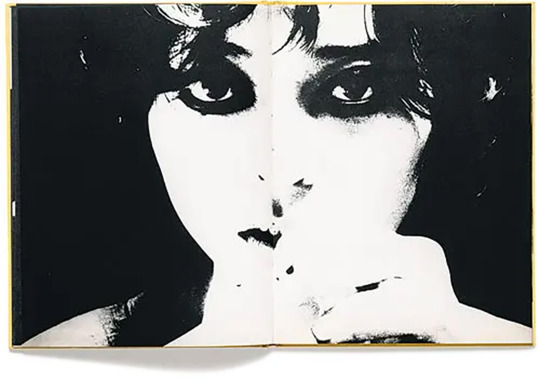

Pages from Eikoh Hosoe’s “Man and Woman” (1961) featured in Japanese photobooks of the 1960s and ’70s by Ryuichi Kaneko and Ivan Vartanian, published by Aperture, New York / USA, 2008
#Japanese photobooks of the 1960s and ’70s#ryuichi kaneko#ivan vartanian#photobook#graphic design#photography#Eikoh Hosoe#yonezawa#Japan#nyc#new york#USA
16 notes
·
View notes
Photo

JAPANESE PHOTOBOOKS OF THE 1960s AND '70s | By Ryuichi Kaneko and Ivan Vartanian
In postwar Japan the photobook, in a wide array of guises, overtook the print as a popular artistic medium for photographers. Above, pages from Eikoh Hosoe's "Man and Woman" (1961).
1 note
·
View note
Photo

大絶滅。 金子隆一
実業之日本社
カバーイラストレーション=ヒロ杉山
47 notes
·
View notes
Text


Kikuji Kawada
https://aperture.org/editorial/kikuji-kawada-conversation-ryuichi-kaneko
4 notes
·
View notes
Photo

some photo books from my home library:
Ikko Narahara
Halo - Rinko Kawauchi
Skin Of The Nation - Shomei Tomatsu
Yasuzo Nojima
Small Things in Silence - Yamamoto Masao
Provoke: Between Protest and Performance: Photography in Japan 1960-1975 -Araki Nobuyoshi; Daido Moriyama; Eikoh Hosoe; Ryuichi Kaneko (I bought this new for only $0.25 at the Art Insitute of Chicago’s bookstore a couple of years ago!)
116 notes
·
View notes
Photo

NUMBERS MATTER 121
チハルMK 、 おたこ、 川畑優、 AGF、 日野繭子、 大西蘭子
Thursday 22 October – 9pm (UK time) | Free
IKLECTIK YouTube Channel: https://youtu.be/HXFmH46kVEQ
Why numbers matter: Japan, a country with a population of over 124.2 million, is ranked at 121 in the Gender Inequality Index (GII) published by Human Development Reports 2020. Japanese women got the vote in 1946 – earlier than China (1949), Liechtenstein (1984) and Switzerland (1993).
In the ranking chart of the Global Gender Gap 2020, the top ten reads as follows: 1: Iceland; 2: Norway; 3: Finland; 4: Sweden; 5: Nicaragua; 6: New Zealand; 7: Ireland; 8: Spain; 9: Rwanda; 10: Germany. The UK ranked 21, following Albania at number 20. Though Japan falls some 100 places behind the UK, the latter’s ranking at 21 is nothing to be proud of either. Clearly there is plenty of work to be done in both countries. Hence, NUMBERS MATTER 121 features four special projects led by Japanese women: Chiharu MK, Otaco, Yu Kawabata (in collaboration with German poemproducer AGF) and Mayuko Hino.
Footnote: In the Press Freedom Index published in 2020, Japan and the UK don’t fare much better than in the GII. Out of 180 countries listed, the UK is ranked at 33 and Japan at 66. The countries listed from one to ten are as follows: Norway, Finland, Denmark, the Netherlands, Jamaica, Costa Rica, Switzerland, New Zealand, Portugal and Germany.
Programme:
“Paramnesia 2020” by CHIHARU MK
“Tomodachi” by OTACO
“Hamaderea Park ” by YU KAWABATA (sound) + AGF (visuals)
“Toyosu 2020″ by MAYUKO HINO

Chiharu MK is from Sapporo. Primarily trained as a composer, she studied the acousmonium, that is, the sound diffusion system, at INA-GRM studio in Paris. Since completing her studies in 2002, she has become an internationally recognised electroacoustic sound artist, either performing or creating sound installations for festival, gallery or non-concert hall spaces in Europe, Hong Kong and Japan. For Intersect 2015, she commissioned the non-Japanese artists Francisco López, Sogar and Taylor Deupree to compose sounds for a 17.1 multi Channel Speaker System (consisting of seven speakers + ten screen speakers + one woofer) in Sapporo city centre’s underground walkway. Chiharu MK has also released three solo CDs: https://www.studio-cplus.net/
Chiharu MK’s new multimedia work Paramnesia 2020 is based on her original piece for Hong Kong Art Centre’s 40th anniversary multi-channel Sound Forms festival in 2018.
This film shows her performing the piece inside Glass Pyramid, nicknamed Hidamari – Japanese for Sunny Spot, it’s the centrepiece of Sapporo’s Moerenuma Park, designed by Japanese American sculptor Isamu Noguchi (1904–1988). Construction work on the park actually began in the year Noguchi died, and it opened in 2005. The film also shows Chiharu MK recording on Ishikari beach, just north of Sapporo.
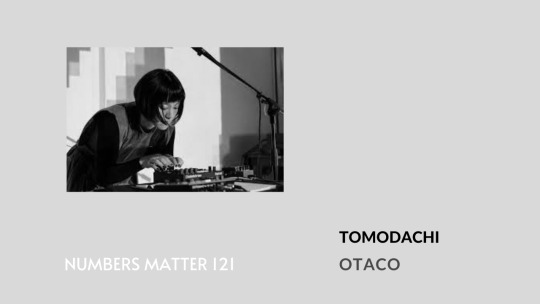
Taking her name from tako, the Japanese word for octopus, Otaco is originally from Japan’s northernmost main island Hokkaido. An electronic musician and vocalist, Otaco is one of the most vibrant and engaging performers to emerge from the alternative music scene anywhere in Japan.
Now living in Tokyo, she operates a home studio set-up of a rhythm box with a synthesizer; she samples and syncs sounds into a computer, running them into real-time sequences to construct her outre pop-electronica songs and instrumentals. Her music can be heard at https://otacosan.bandcamp.com/music. Otaco also plays guitar when she leads Gotou, an occasional rock trio formed out of homage to early 1980s West Berlin groups Mania D and Malaria!. She appeared for the first time in the UK during Coding In GE 2018 festival for women and technology.

Antye Greie also know as AGF was born and raised in East Germany. She is a vocalist, digital songwriter, producer, performer, e-poet, calligrapher, digital media artist. In the last decade Greie has released more than 20 full length records and played over 300 live performances worldwide.
AGF runs her own production company AGF Production – http://antyegreie.com
She first worked with Yu Kawabata on her 2015 album A Deep Mysterious Tone, the third in AGF’s series of settings and poetry interpretations from different countries, this one featuring Japanese poets and writers including Noe Ito, Fumiko Kaneko, Shikubu Izumi, Blue Stocking editor and writer Hiratsuka Raicho, and more.
Yu Kawabata is a techno DJ active in Japan and Russia. This is Yu and AGF’s second collaboration. On their first, AGF set to music Yu’s reading of a waka poem, written by the 12th century court lady Yūshi Naishinnō-ke no Kii, enumerated as one of the Thirty-Six Female Immortals of Poetry. On their latest, Yu has created new music for a film by AGF.
https://soundcloud.com/yukawabata
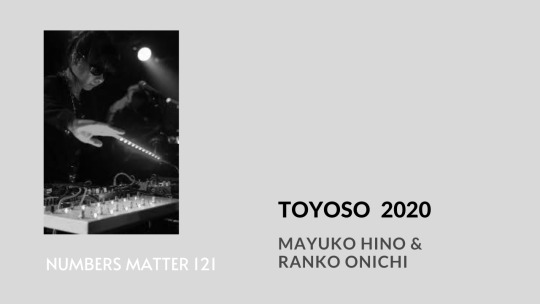
Since resuming music in 2011 after a ten year break to study Chinese medicine, Mayuko Hino has reclaimed her status as queen of noise.
A prolific live performer, Hino is best known for C.C.C.C. (Cosmic Coincidence Control Center), the group she formed in 1990 with Hiroshi Hasegawa, Fumio Kosakai and Ryuichi Nagakubo. In their early phase, the band grabbed attention by combining noise music with Hino’s sadomasochism performances using bondage ropes and dripping candle wax. Hino has since been a member of Mne-Mic, DFH-M3 and her most recent group Transparentz with Akira Sakata, who split up in January 2020.
Whether solo or in her various group projects, Hino experiments with the function of noise music as a transdisciplinary medium, in the process to breaking the boundaries surrounding performance art: urban structure against man, art against non art, activity versus rest.
In 2018 Mayuko Hino performed at Iklectic’s Coding In GE Festival alongside and in collaboration with Ramleh. The same year she released her second solo album Lunisolar. In addition to self-made instruments, Hino plays noise with her six-theremin oscillators (in bright pink), a unique device specially made for her by Ryo Araishi (aka ichion)
This year Hino had planned to resume activities with C.C.C.C. to mark the US reissue of their first four albums, but unfortunately their plans had to be put on hold because of the pandemic.
“There’s a sense of momentum to be found in Hino’s noise; it’s rarely static… At the hands of Hino it seems astral travelling is as much out-of-this-world as it is an out-of-body experience… on Lunisolar she continues with the ever evolving atmospheric and psychedelic sound that energised the noise of C.C.C.C.” (Compulsion Online)
“Hino Mayuko makes no bones about her wide-ranging noisician flexibility here, nor her honored place in the contemporary Japanoise scene… Unlike a bevy of artists who just make ear-splitting sonic somersaults, Hino’s sound is more impressionistic and staggered in its delivery, incorporating a yin/yang of the industrial and environmental.” (Tone-Shift)
RANKO ONISHI (Mne-mic): voice
Performing artist Ranko Onishi was born in Hokkaido. She moved to Tokyo where she joined Shuji Terayama’s Tenjo Sajiki theatre company in 1980. She was a second year student of dancer Min Tanaka in 1982 and became a full member of Tanaka’s company in 1984. Five years later in 1989 she performed with Keiji Haino. She and Hino work together in the duo Mne-mic, featuring Hino on electronics, Theremin and synthesizer, and Onishi on voice, water and fogphone. Their album Gulf Stream was released by Alchemy Records in 1999.
Curator Keiko Yoshida’s notes for NUMBERS MATTER 121
While researching texts for AGF’s 2015 CD A Deep Mysterious Tone I developed a profound interest in women’s history in Japan. AGF and I first met and begain talking about her project while she was taking part in my hometown Sapporo’s International Arts Festival in 2014. For the album she compiled and set to music Japanese writings and poems from the ninth century to the present day, and commissioned the female electronic musicians Ryoko Akama (UK), Kyoka (Germany), Tujiko Noriko (France) and Yu Kawabata to read her selections. She had met them at European festivals, and as she got to know them she learnt these female electronic musicians are not treated very well when they’re back home in Japan.
Indeed NUMBERS MATTER 121 took seed in these discussions on women and Japan with AGF. In some ways it’s also a sequel to “Coding in GE”, the 2018 Iklectik festival offering a platform to female electronic musicians, for which we got funding from Sasakawa Foundation UK, and in which Otaco, Mayuko Hino and AGF participated.
Another question addressed in NUMBERS MATTER 121 is the subject of decentralisation. I consciously asked musicians from outside Tokyo to participate in this project.
Currently working on a photo story book about 1980s London and Berlin.
Please support the project buying an e-ticket (#nameyourprice).
** https://buytickets.at/iklectik/439711 **
2 notes
·
View notes
Video
youtube
Kikuji Kawada is a renowned Japanese photographer famous for his series 'The Map' depicting post war Japan.
https://aperture.org/editorial/kikuji-kawada-conversation-ryuichi-kaneko/
1 note
·
View note
Photo

SHIN YANAGISAWA /Japanese, 1936 -2008
from photobook ‘ Untitled’ / Publisher: Roshin Books 2017
/ Untitled collects photography shot throughout Japan between 1965 and 1992.
ph source & credit: © PhotoBookStore
... Yanagisawa photography was highly regarded by contemporaries such as Daido Moriyama and Ryuichi Kaneko. From 1963 on, after having recovered from an illness, Yanagisawa focused on photographing a variety of places throughout Japan. It was Yanagisawa’s philosophy to create photos that require no further commentary, that already say and contain everything there is to convey.
Yanagisawa held only four exhibitions in his lifetime and published only three photobooks. He chose to focus on his work at his own pace, ignoring trends in contemporary photography. In the 1970s
#shin yanagisawa#japanese photography#yanagisawa shin#fog#cityscape#photography#black and white#mu photo#mu
9 notes
·
View notes
Photo

Ryuichi Kaneko - Nippon, Box 1, Volumes 1 to 12 - 2002 - Published by Kokusho kankokai - 722 pages - 32 x 45 cm
Contains 12 magazines:
Volume 1 - 64 pages - 25,7 x 36,2 cm - October 1934 (Autumn, Nippon I)
Volume 2 - 66 pages - 25,7 x 36,2 cm - January 1935 (Winter, Nippon II)
Volume 3 - 64 pages - 25,7 x 36,2 cm - April 1935 (Spring, Nippon III)
Volume 4 - 64 pages - 25,7 x 36,2 cm - July 1935 (Summer, Nippon IV)
Volume 5 - 56 pages - 25,7 x 36,2 cm - October 1935 (Autumn, Nippon V)
Volume 6 - 60 pages - 25,7 x 36,2 cm - February 1936
Volume 7 - 64 pages - 25,7 x 36,2 cm - May 1936
Volume 8 - 56 pages - 25,7 x 36,2 cm - August 1936
Volume 9 - 64 pages - 25,7 x 36,2 cm - November 1936
Volume 10 - 54 pages - 25,7 x 36,2 cm - March 1937
Volume 11 - 54 pages - 25,7 x 36,2 cm - May 1937
Volume 12 - 56 pages - 25,7 x 36,2 cm - July 1937
Reissue. Softcover photobooks. In very good condition.
https://www.bakunen.com/ryuichi-kaneko-nippon-box-1-volumes-1-to-12-2002
0 notes
Text
Photography – New York Times
New York Times PhotographyNew York Times… Fukase by Tomo Kosuga ✦; Shomei Tomatsu by Juan Vicente Ariaga, Ryuichi Kaneko, Hiromi Kojima and Carlos Martín García ✦; Brassaï by Peter Galassi, Stuart Alexander and Antonio Muñoz Molina ✦; The Street Philosophy of Garry Winogrand by Geoff Dyer … Libro La Semilla Libros Autoayuda y Crecimiento Personal
source http://news.google.com/news/url?sa=t&fd=R&ct2=es&usg=AFQjCNHRT32PcMVwnyMRTF_ILwUBOPI9Yg&clid=c3a7d30bb8a4878e06b80cf16b898331&ei=I9n_W8ipFM7Q3gG_k7jADg&url=https://www.nytimes.com/interactive/2018/books/review/photography-books.html
0 notes
Text
SHOMEI TOMATSU – MAPFRE RETROSPECTIVE CATALOGUE

La Fondation MAPFRE présente actuellement l’exposition Shomei Tomatsu, montrant pour la première fois à Barcelone l’œuvre unique de ce grand photographe japonais, dont le travail couvre les événements clés de l’histoire du Japon après la Seconde Guerre mondiale. Shomei Tomatsu (1930- 2012) est né “à l’ombre de la guerre”, dans un contexte de dévastation et de la pauvreté. Le Japon était alors un pays vaincu et occupé par les troupes américaines. Un pays où l’écho de l’explosion des bombes atomiques sur les villes d’Hiroshima et de Nagasaki retentissait encore dans la mémoire. Shomei Tomatsu avait 20 ans lorsqu’il a commencé à photographier. La technique ne lui était pas étrangère, car ses deux frères utilisaient déjà l’appareil photo et s’étaient même improvisé une chambre noir dans un placard. Il devient rapidement une figure incontournable de la photographie japonaise d’après-guerre et de la photographie contemporaine mondiale, notamment grâce au succès de ses deux séries “Scars” et “Nagasaki”. Son travail est celui d’un observateur attentif de la vie quotidienne ainsi que du passé et du présent de son pays. Ce catalogue de la grande rétrospective retrace ainsi son travail des années 1950 aux années 2000, à travers les principales thématiques récurrentes de son œuvre : les conséquences de la guerre, les protestations sociales, les corps abîmés ou marginaux, l’occupation américaine, Okinawa, la culture japonaise traditionnelle… Le livre présente ainsi près de 180 clichés du photographe, en couleur et noir et blanc. Tomatsu dit que l’utilisation du noir et blanc était associée à la présence des États-Unis au Japon, tandis que la couleur était une affirmation de la vie retrouvée à Okinawa, qu’il a visité pour la première fois en 1969 et où il a vécu au cours de ses dernières années. Shomei Tomatsu livre des images à la fois crues et lyriques qui restent parmi les plus belles de l’histoire de la photographie. Avec des textes de Juan Vicente Aliaga, Ryuichi Kaneko et Hiromi Kojima, le livre constitue une exploration approfondie de l’univers visuel de Tomatsu. Ce très bel ouvrage est maintenant disponible en librairie ainsi que sur Amazon.com.
(...)
Read the rest of SHOMEI TOMATSU – MAPFRE RETROSPECTIVE CATALOGUE
© 2016 Guillotine | Permalink | Posted in : Art | facebook | twitter | instagram

The post SHOMEI TOMATSU – MAPFRE RETROSPECTIVE CATALOGUE appeared first on Guillotine.
from pussyfoott2b https://glltn.com/2018/08/shomei-tomatsu-mapfre-retrospective-catalogue/
via http://www.rssmix.com/
0 notes